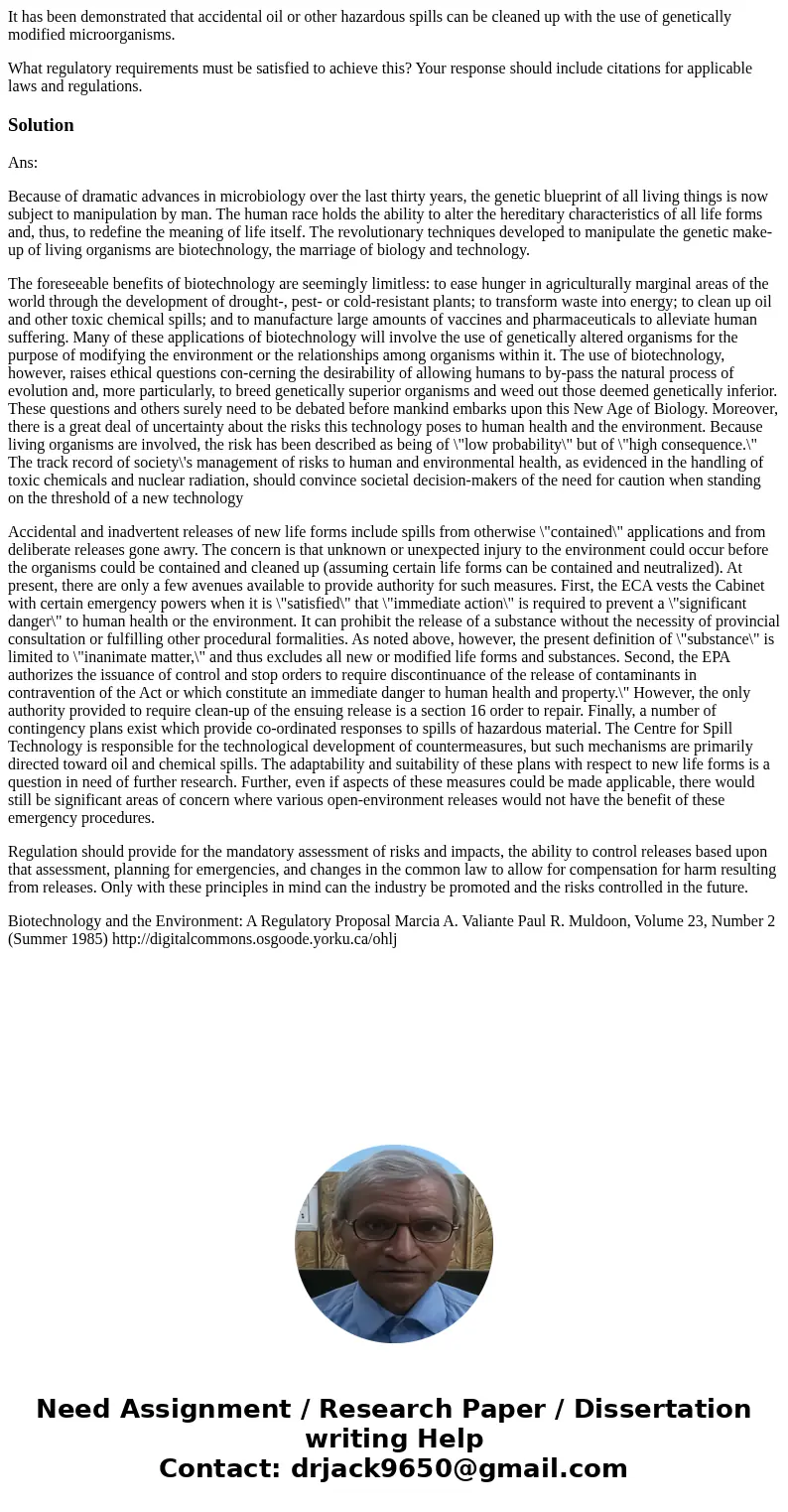It has been demonstrated that accidental oil or other hazard
It has been demonstrated that accidental oil or other hazardous spills can be cleaned up with the use of genetically modified microorganisms.
What regulatory requirements must be satisfied to achieve this? Your response should include citations for applicable laws and regulations.
Solution
Ans:
Because of dramatic advances in microbiology over the last thirty years, the genetic blueprint of all living things is now subject to manipulation by man. The human race holds the ability to alter the hereditary characteristics of all life forms and, thus, to redefine the meaning of life itself. The revolutionary techniques developed to manipulate the genetic make-up of living organisms are biotechnology, the marriage of biology and technology.
The foreseeable benefits of biotechnology are seemingly limitless: to ease hunger in agriculturally marginal areas of the world through the development of drought-, pest- or cold-resistant plants; to transform waste into energy; to clean up oil and other toxic chemical spills; and to manufacture large amounts of vaccines and pharmaceuticals to alleviate human suffering. Many of these applications of biotechnology will involve the use of genetically altered organisms for the purpose of modifying the environment or the relationships among organisms within it. The use of biotechnology, however, raises ethical questions con-cerning the desirability of allowing humans to by-pass the natural process of evolution and, more particularly, to breed genetically superior organisms and weed out those deemed genetically inferior. These questions and others surely need to be debated before mankind embarks upon this New Age of Biology. Moreover, there is a great deal of uncertainty about the risks this technology poses to human health and the environment. Because living organisms are involved, the risk has been described as being of \"low probability\" but of \"high consequence.\" The track record of society\'s management of risks to human and environmental health, as evidenced in the handling of toxic chemicals and nuclear radiation, should convince societal decision-makers of the need for caution when standing on the threshold of a new technology
Accidental and inadvertent releases of new life forms include spills from otherwise \"contained\" applications and from deliberate releases gone awry. The concern is that unknown or unexpected injury to the environment could occur before the organisms could be contained and cleaned up (assuming certain life forms can be contained and neutralized). At present, there are only a few avenues available to provide authority for such measures. First, the ECA vests the Cabinet with certain emergency powers when it is \"satisfied\" that \"immediate action\" is required to prevent a \"significant danger\" to human health or the environment. It can prohibit the release of a substance without the necessity of provincial consultation or fulfilling other procedural formalities. As noted above, however, the present definition of \"substance\" is limited to \"inanimate matter,\" and thus excludes all new or modified life forms and substances. Second, the EPA authorizes the issuance of control and stop orders to require discontinuance of the release of contaminants in contravention of the Act or which constitute an immediate danger to human health and property.\" However, the only authority provided to require clean-up of the ensuing release is a section 16 order to repair. Finally, a number of contingency plans exist which provide co-ordinated responses to spills of hazardous material. The Centre for Spill Technology is responsible for the technological development of countermeasures, but such mechanisms are primarily directed toward oil and chemical spills. The adaptability and suitability of these plans with respect to new life forms is a question in need of further research. Further, even if aspects of these measures could be made applicable, there would still be significant areas of concern where various open-environment releases would not have the benefit of these emergency procedures.
Regulation should provide for the mandatory assessment of risks and impacts, the ability to control releases based upon that assessment, planning for emergencies, and changes in the common law to allow for compensation for harm resulting from releases. Only with these principles in mind can the industry be promoted and the risks controlled in the future.
Biotechnology and the Environment: A Regulatory Proposal Marcia A. Valiante Paul R. Muldoon, Volume 23, Number 2 (Summer 1985) http://digitalcommons.osgoode.yorku.ca/ohlj

 Homework Sourse
Homework Sourse